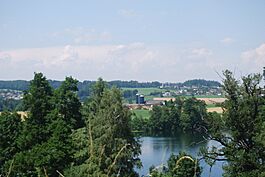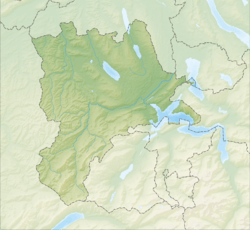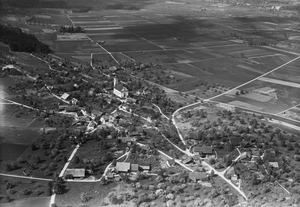Knutwil facts for kids
Quick facts for kids
Knutwil
|
||
|---|---|---|
 |
||
|
||
| Country | Switzerland | |
| Canton | Lucerne | |
| District | Sursee | |
| Area | ||
| • Total | 9.74 km2 (3.76 sq mi) | |
| Elevation | 541 m (1,775 ft) | |
| Population
(Dec 2020 )
|
||
| • Total | 2,271 | |
| • Density | 233.16/km2 (603.9/sq mi) | |
| Postal code |
6212-6213
|
|
| Surrounded by | Büron, Dagmersellen, Geuensee, Mauensee, Sursee, Triengen, Winikon | |
Knutwil is a small town, also called a municipality, in the canton of Lucerne in Switzerland. It's part of the Sursee district.
Contents
Knutwil's Past: A Look at History
Knutwil was first mentioned a long time ago, in the early 12th century. Back then, it was known as Gnuthwilare. Later, in 1245, its name changed to Knutwile, which is very close to what we call it today!
Knutwil's Location and Land
Knutwil covers an area of about 9.8 square kilometers (that's about 3.8 square miles). A big part of this land, around 69%, is used for farming. Forests cover about 20% of the area. The rest of the land is where buildings and roads are (about 10.7%), or it's natural areas like rivers (a tiny 0.2%).
In 1997, about one-fifth of Knutwil's land was covered by trees. Most of the farming land is used for crops or pastures for animals. A small part is used for growing fruits or grapes.
The town is located on a line of hills. These hills are on the southwest side of an area called the Surental. Knutwil isn't just one village; it also includes smaller communities like St. Erhard, Eriswil, Wolen, Schaubern, and Hitzligen.
Who Lives in Knutwil? (Demographics)
Knutwil has a population of about 1,089 people (as of 2022). Over the past ten years, the number of people living here has grown by about 7.9%. Most people in Knutwil speak German (about 97.2%). A smaller number speak Serbo-Croatian (0.9%) or French (0.4%).
Politics and Elections
In the 2007 election, the most popular political group was the CVP. They received about 36.5% of the votes. Political parties are groups of people who share similar ideas about how the country or town should be run. Other popular parties were the FDP (27.2%) and the SVP (24%).
Age Groups in Knutwil
The people in Knutwil are of all ages!
- About 25.7% of the population are young people, aged 0 to 19 years old.
- Around 24.5% are young adults, aged 20 to 39 years old.
- The largest group, about 36.2%, are adults aged 40 to 64 years old.
- Older adults, aged 65 to 79, make up about 10.9% of the population.
- A small number, 2.4%, are aged 80 to 89.
- And a very small group, 0.2%, are 90 years old or older.
Education and Homes
Most people in Switzerland are well-educated. In Knutwil, about 74% of adults (aged 25-64) have finished high school or gone on to higher education, like a university.
In 2000, there were 564 homes in Knutwil. About 22.9% of these homes had only one person living in them. About 13.5% were large homes with five or more people. Most of the buildings in Knutwil are houses, with many being two or three stories tall.
Jobs and Work
Knutwil has a low unemployment rate, meaning most people who want to work can find a job. In 2005, many people worked in different types of jobs:
- Primary sector: This includes jobs like farming. About 127 people worked in this area.
- Secondary sector: These are jobs in manufacturing or building things. About 175 people worked here.
- Tertiary sector: This includes jobs in services, like shops, offices, or schools. About 282 people worked in this sector.
In 2000, about 52.9% of the people in Knutwil had jobs. Women made up about 39.5% of the workforce.
Religion in Knutwil
In 2000, most people in Knutwil were Roman Catholic (about 81.6%). About 8.8% were Protestant. There were also smaller groups of other Christian faiths and Muslim people. Some people did not belong to any organized religion.
Population Changes Over Time
Here's how Knutwil's population has changed through history:
| year | population |
|---|---|
| 1574 | 304 |
| 1850 | 1,316 |
| 1900 | 933 |
| 1950 | 986 |
| 2000 | 1,583 |
See also
 In Spanish: Knutwil para niños
In Spanish: Knutwil para niños





